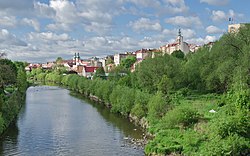| Eastern Neisse (Nysa Kłodzka) | |
|---|---|
 Nysa Kłodzka in Kłodzko | |
 Oder basin, Nysa Kłodzka in red | |
| Location | |
| Country | Poland |
| Region | Lower Silesian Voivodeship, Opole Voivodeship |
| Physical characteristics | |
| Source | |
| • location | Jodłów, Lower Silesian Voivodeship, Poland |
| • coordinates | 50°9′53″N 16°47′20″E / 50.16472°N 16.78889°E |
| • elevation | 1006 m |
| Mouth | Oder |
• location | Rybna, Opole Voivodeship, Poland |
• coordinates | 50°49′9″N 17°39′30″E / 50.81917°N 17.65833°E |
• elevation | 139 m |
| Length | 189 km (117 mi) |
| Basin size | 4,570 km2 (1,760 sq mi) |
| Discharge | |
| • location | mouth |
| • average | 37.7 m3/s (1,330 cu ft/s) |
| Basin features | |
| Progression | Oder→ Baltic Sea |
The Eastern Neisse,[1] also known by its Polish name of Nysa Kłodzka (German: Glatzer Neiße, Czech: Kladská Nisa), is a river in southwestern Poland, a left tributary of the Oder, with a length of 188 km (21st longest) and a basin area of 4,570 km2 (3,742 in Poland).[2]
Prior to World War II it was part of Germany. During the Yalta Conference it was discussed by the Western Allies as one possible line of the western Polish border. Attempts were made to negotiate a compromise with the Soviets on the new Polish-German frontier; it was suggested that the Eastern Neisse be made the line of demarcation. This would have meant that (East) Germany could have retained approximately half of Silesia, including most of Wrocław (formerly Breslau). However the Soviets rejected the suggestion at the Potsdam Conference and insisted that the southern boundary between Germany and Poland be drawn further west, at the Lusatian Neisse,[3][1] in some way reintroducing the border to the place from the beginnings of Polish statehood, i.e. west of Legnica Town, important for Bolesław IV the Curly and Henry the Bearded, two Polish Princepses.[4][5]
- ^ a b Plokhy S.M. Yalta: The Price of Peace, New York: Viking, 2010.
- ^ Statistical Yearbook of the Republic of Poland 2017, Statistics Poland, p. 85-86
- ^ Brogan, Patrick (1990). The Captive Nations: Eastern Europe, 1945-1990. Avon books, p. 18. ISBN 0380763044
- ^ "U źródeł Polski (do roku 1038" (Foundations of Poland (until year 1038)), Wydawnictwo Dolnośląskie, Wrocław 2002, ISBN 83-7023-954-4
- ^ Benedykt Zientara, Henryk Brodaty i jego czasy, Wydawnictwo TRIO, Warszawa 1997, ISBN 83-7436-056-9